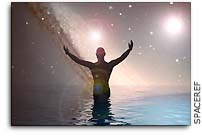Astronomers Find Sugar Molecules In a Dust Cloud at Our Galaxy’s Center

Astronomers have been detecting various molecules in space for decades. The collection of molecules detected now has a significant addition thanks to astronomers using the National Science Foundation’s 12 Meter Radio Telescope at Kitt Peak, Arizona. The molecule discovered is the sugar glycolaldehyde; It was found in Sagittarius B2 (North), a gas and dust cloud 26,000 light years away near the center of our galaxy.
Glycolaldehyde was detected by detecting the faint, yet highly specific radio emissions that the molecules give off. According to the NRAO “molecules rotate end-for-end, and as they change from one rotational energy state to another, they emit radio waves at precise frequencies. The “family” of radio frequencies emitted by a particular molecule forms a unique “fingerprint” that scientists can use to identify that molecule.”
The significance of this discovery? According to the NRAO: “Glycolaldehyde, an 8-atom molecule composed of carbon, oxygen and hydrogen, can combine with other molecules to form the more-complex
sugars Ribose and Glucose. Ribose is a building block of nucleic acids such as RNA and DNA, which carry the genetic code of living organisms.
Glucose is the sugar found in fruits. Glycolaldehyde contains exactly the same atoms, though in a different molecular structure, as methyl formate
and acetic acid, both of which were detected previously in interstellar clouds. Glycolaldehyde is a simpler molecular cousin to table sugar, the
scientists say.”
The fact that molecules such as glycoaldehyde are to be found floating about in the same locations where stars (and solar systems) are formed is rather significant. According to Jan Hollis of NASA’s Goddard Space Flight
Center, this discovery means “it is increasingly likely that the chemical precursors to life are formed in such clouds long before planets develop around the stars.”
According to an NRAO press release, Hollis said that “finding glycolaldehyde in one of these interstellar clouds means that such molecules can be formed even in very rarefied conditions. We don’t yet understand how it could be formed there. A combination of more astronomical observations and theoretical chemistry work will be required to resolve the mystery of how this molecule is formed in space.”
Philip R. Jewell of the National Radio Astronomy Observatory (NRAO) in Green Bank, West Virginia said that “this discovery may be an important key to understanding the formation of life on the early Earth. Conditions in interstellar clouds may, in some cases, mimic the conditions
on the early Earth, so studying the chemistry of interstellar clouds may help scientists
understand how bio-molecules formed early in our planet’s history. In addition, some scientists
have suggested that Earth could have been “seeded” with complex molecules by passing
comets, made of material from the interstellar cloud that condensed to form the Solar System.”
According to NASA’s Michael Meyer, writing in the January 1999 issue of the National Space Society’s magazine Ad Astra “Surveys of our galaxy, and of the universe, show that the elements for life are evenly distributed, to the first order. Furthermore, known interstellar chemistry is encouraging in its ubiquity and complexity of organic chemistry. At the two-atom level, known compounds are diverse and range from molecular hydrogen to aluminum chloride. As the number of atoms in molecular species increase, compounds of carbon, hydrogen, oxygen, and nitrogen predominate, to the exclusion of all other elements in detectable compounds of seven atoms or more. The plethora of organic (i.e. carbon-containing) compounds range from amino acids such as glycine, to complex refractory compounds such as polycyclic aromatic hydrocarbons (PAHs). These days you need to have an organic chemistry book next to your telescope as you explore the universe: the elements and compounds for life seem to be present everywhere and are woven into the very fabric of the cosmos.”
Every time we look closer at the chemical composition of the universe that surrounds us, we find more of the basic components that comprise our own bodies – and that of all life on Earth. The more stars we examine, the more planets we find circling them. Even the skeptics have to pause and wonder why the universe seems to be seen as an ever-more hospitable place for planets and the basic building blocks of life.
Related links
° Scientists Discover Sugar in Space, National Radio Astronomy Observatory
° National Radio Astronomy Observatory
Background Information
° Ex astra: Life From the Stars, Ad Astra magazine
° Astrochemistry, SpaceRef Directory
° Astrochemistry Branch, NASA Goddard Space Flight Center
° NASA’s Origins Program, NASA Jet Propulsion Laboratory
° Astrochemistry, NASA Ames Research Center
° NASA’s Astrobiology Program, NASA Ames Research Center








